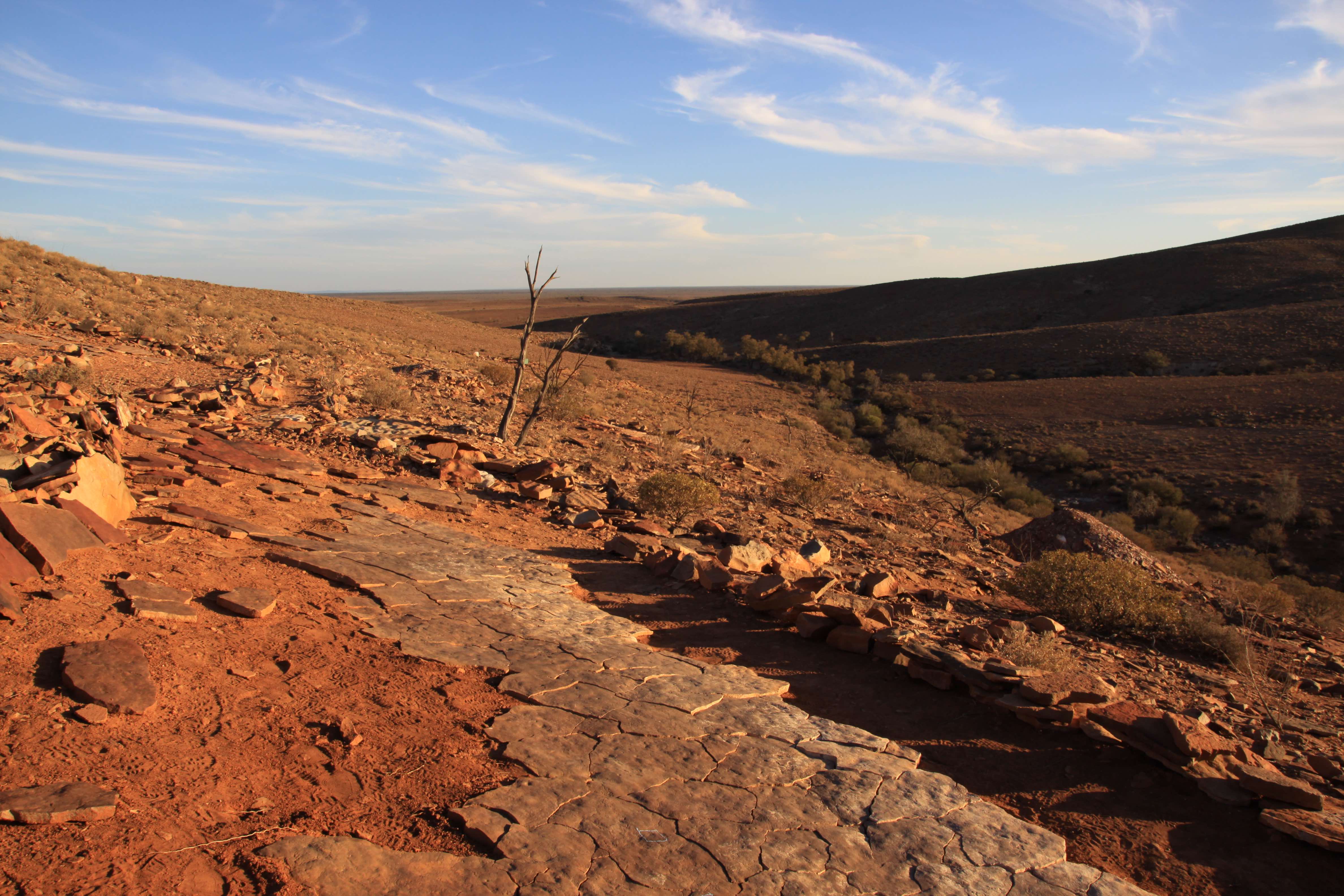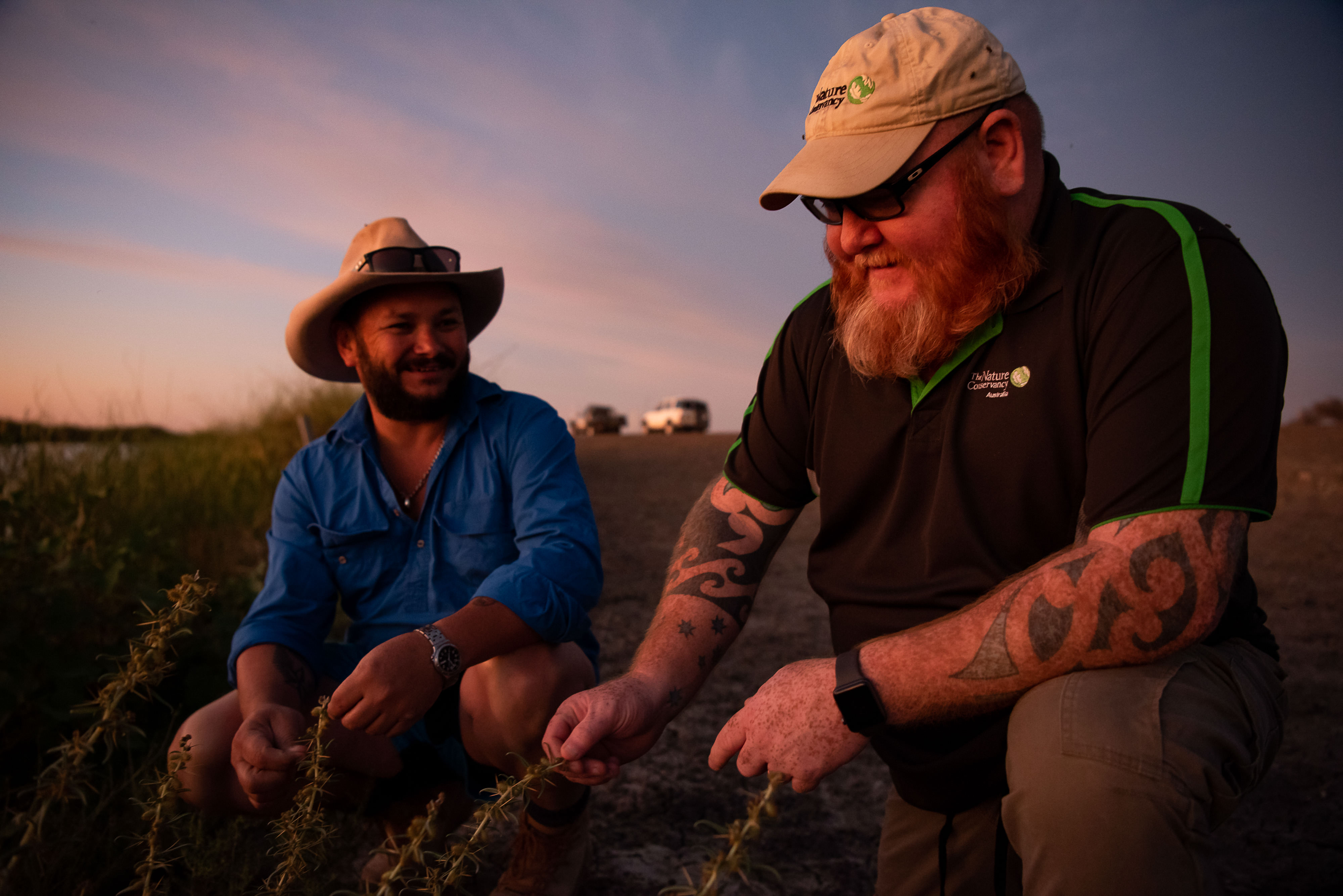For all of us, 2020 were uncertain times. Despite the hurdles, it was not a time to relax our efforts. It gave us more strength to continue to achieve positive outcomes for nature. And we did just that.
There are so many natural places that need to be cared for. And like all conservation projects, it takes actionable science, time and the support of everyday Australians.
Together, with your support and our dedicated team, we achieved so much for Australia’s natural environment.
Learn about the impact we’ve all helped achieve in the Outback, Murray-Darling Basin, Oceans and for bushfire recovery.

Outback
The Nature Conservancy is well known for supporting indigenous communities to manage fire.
As well as restoring the health and diversity of ecosystems, early dry season burning results in huge reductions in greenhouse gas emissions in Australia’s northern savannas.
For over 50,000 years Indigenous Australians lit small fires to help them hunt for food, improve access through the bush and protect culturally important places. Working with Indigenous partners, we support them to combine this traditional ecological knowledge with the latest in fire science to manage fire across vast areas of Australia. Rangers set strategically placed small fires at the right time of year, which burn cool and low. This recreates the mosaic pattern of burning, to support a wider diversity of wildlife and quell raging late dry season wildfires.
Indigenous communities are achieving some amazing outcomes. In 2020, 26 groups were supported, contributing to a system that has seen:
-

6
Million tonnes of carbon abated through cool season burns
-

19
Million hectares with Indigenous carbon projects since 2012
-

24
Indigenous communities with Healthy Country Plans since 2010
Reducing carbon emissions
“Without regular people-lit fires in the cooler months, dry grass builds up, creating fuel for much bigger bushfires. Hotter, larger fires can have a devastating effect on vegetation and animals in their path, and release huge volumes of greenhouse gases into the atmosphere,” says Outback Program, Director David Hinchley.
“Supporting Indigenous communities to return to traditional practices is simply sustainable conservation in action. Managed fire can have huge benefits for people and nature through biodiversity outcomes and climate change mitigation. This creates diversified income streams through carbon credits which is a game changer for these communities”
Through this improved burning and reduced greenhouse gas emissions, carbon credits are generated, where one less tonne of carbon dioxide emitted equals one carbon credit. Credits can be sold, to offset the emissions of other organisations, generating income which in turn is used for conservation land management.
Reflecting on our work up north with eight Indigenous groups on Cape York doing early-season fire management and savanna burning carbon projects, David’s colleague Dr Luke Preece says, “Creating these carbon credits is key in enabling groups to manage Country and build better lives for communities.”
Fire planning reviews assesses the success of the previous year’s fire program. The results are good! Across northern Australia, the last fire season was better than the year before, making ecosystems healthier and abating 954,000 tonnes of carbon for Indigenous-led projects alone. We’re now seeing a growing Indigenous carbon industry network which is impacting positively on Indigenous leadership.
The Healthy Country Planning (HCP) approach is showing great results too. The plans provide a critical foundation for communities to realise cultural and conservation aspirations for their country. In 2020, we supported four groups on Cape York to help create their plan.
These communities are now focussing on how to maintain the positive outcomes achieved so the benefits are ongoing well into the future.

Empowering women in the outback
We have a strong focus on equity across our work in the outback. We work with women leaders on Cape York and Arnhem Land with an emphasis is on women’s empowerment and includes women and girls from several generations.
In Arnhem Land, we supported the Mimal Land Management Aboriginal Corporation to establish the Northern Territory Strong Women Healthy Country Network. The network is growing, with over 100 women Elders, rangers and supporters.
And at Fish River Station in the Northern Territory, a women’s camp was built. The camp has increased women's engagement. It’s providing a foundation for long-term management with the ultimate goal of hand-back to Traditional Owners. This leads to better conservation outcomes for people and nature.


FEATURE STORY
Nilpena Station
The acquisition of a large part of Nilpena Station was finalised in 2020.
Nilpena is an internationally significant fossil site and area of high conservation value in outback South Australia. Thanks to a partnership between TNC and the Wyss Campaign for Nature, the property is now permanently protected and managed for conservation by the South Australian Government.
Nilpena will be the centrepiece for a new Nilpena Ediacara National Park to be declared later in 2021.
“The protection of this 60,000 hectare former pastoral property marks a huge win for conservation. The property contains significant biodiversity values including two threatened ecological communities and a number of threatened species. Most critically, the property also covers extremely important sites that contain the oldest fossilised animals on Earth,” said Dr James Fitzsimons, Director of Conservation and Science.
TNC continues to work with the Wyss Foundation and state governments to identify other significant lands around Australia for long-term protection.
Murray Darling Basin

Finding creative, science-based solutions to our biggest conservation challenges is a hallmark of TNC’s approach across the world. Focussing on the largest-scale impact is what our team work toward every single day.
Our approach to protecting habitat in the lower Murray-Darling Basin is a great example of this.
-

1,244
Megalitres of water returned to wetlands
-

361
Hectares of wetland area
-

6
Wetlands received water
-

50+
Waterbird species surveyed at Gayini
We’d established the world’s first impact investing project in Australia with the Murray-Darling Basin Balanced Water Fund. The Fund works to make water available for farmers when they need it most, while protecting culturally significant wetlands that support threatened species and ecosystems.
In 2020, we returned 1,244 megalitres of water to wetlands located in northern Victoria and south-western NSW.
By investing in permanent water rights in the southern Murray-Darling Basin, we can, through smart allocation of those rights, optimise agricultural and environmental outcomes by replicating the natural wetting and drying cycles of the Basin. By copying nature.
Another property receiving environmental waterflows is Gayini. It’s a place of conservation and cultural significance to the Traditional Custodians, the Nari Nari people.
In December 2020, surveys were undertaken of a known Ibis breeding site. Around 18,500 nests belonging to Straw-necked Ibis’ and Glossy Ibis’ were surveyed.
The Glossy Ibis is the smallest of the three species of ibis in Australia. It’s considered vulnerable in NSW and Victoria due to the loss of wetland ecosystems. This significant breeding event is especially exciting as it’s one of the largest breeding events ever recorded on Gayini. It demonstrates the positive impact of environmental flows returning to Gayini’s wetlands and floodplains.
Ongoing bird surveys have identified a number of threatened birds across Gayini including the White-fronted Chat, Blue-billed Duck and Freckled Duck.
Waterbird species surveyed at Gayini





FEATURE STORY
Gayini handback
While COVID-19 cancelled official celebrations, nothing could have put a dampener on the joy we felt at the handback of Gayini to its Traditional Custodians the Nari Nari people in early 2020. Gayini is a magical landscape. The property spans almost 88,000 hectares of internationally significant Murrumbidgee River floodplain in southern New South Wales.
We are proud to have facilitated the official transfer, with Gayini now legally owned by the Nari Nari, as it has been spiritually for 50,000 years.
The process took around 12 months from raising funds through our loyal supporters and corporate partners, to purchase the property to achieve the ultimate objective of returning it to its Traditional Custodians. In 2020, less than 3% of land in the Murray-Darling Basin is owned by Traditional Owners.
“Our people managed this area for 50,000 years and left their footprints on the Country. Now it’s our turn to protect, maintain and enhance our culture and Country and leave our footprints once again” said Ian Woods, Nari Nari Tribal Council.
The recent discovery of the critically endangered Plains-wanderer—a grassland dependent, ground dwelling bird—is a thrilling indication that current management practices are benefitting threatened wildlife. TNC remain involved, including managing an Environmental Fund to support Gayini’s Land and Water Management Plan. This plan seeks to improve the conservation values of the property over the long term.
Bushfire Recovery
Thank you to everyone who donated to our bushfire appeal. We received an outpouring of support from all corners of the globe. But the fight is nowhere near over. Our response to bushfire recovery was swift and remains ongoing.
In an unprecedented coordinated effort, we worked with over 50 farming, conservation and land management organisations to create a plan that is a practical, tangible and a responsible way to invest in long-term, landscape-scale initiatives in bushfire-affected areas and beyond.
It brings together government, the private sector and philanthropy to invest in Australia’s natural environment at a scale much greater than government could achieve alone.
Rest assured, we’re working tirelessly to get it across the line. If it gets up, it will a significant advance in the funding of conservation in Australia’s working landscapes.
Thank you for being there during the toughest bushfire season in our history.
Oceans

Oyster reefs are one of Australia’s most critically endangered marine ecosystems.
Shellfish reefs are made up of billions of oysters and mussels that work like a coral reef, these rich ecosystems support fish and other marine species. They help clean water, provide more fish and safer coastlines. They’re also excellent natural water filters. One adult oyster can filter up to a bathtub of water a day.
Shellfish reefs once thrived in Australia’s bay and estuaries from Noosa in Queensland, right around Australia’s southern coastline to Perth in Western Australia. Now less than 10% remain.
-

45
Shellfish reefs built
-

4
Locations
-

6
Hectare area covered by new reefs
-

266
Tonnes of recycled shells used
We’re leading a bold commitment to build 60 reefs alongside communities who need them most. It’s the largest marine restoration initiative to bring back shellfish reef ecosystems from the brink of extinction—for the benefit of people and nature.
We've successfully built shellfish reefs all over the world, with many projects already well underway in Australia. So far we’ve completed projects in:
- Oyster Harbour, Western Australia
- Port Phillip Bay, Victoria
- Gulf St Vincent and Glenelg, South Australia.
More projects are in progress. The success of these projects have demonstrated that shellfish reefs can be restored at scale and their benefits returned.
“Our supporters are helping us bring an entire ecosystem back from the brink. In 2020, we built shellfish reefs over a six hectare area. To put that in perspective, that’s about the size of nearly 3.5 football ovals,” said Dr Chris Gillies, Oceans Director.
“We seeded these reefs with four million oysters and mussels, which, along with the 14 million seeded in previous years, will form the basis of a thriving ecosystem. Monitoring progress is vital, with our team spending close to 400 hours scuba diving underwater, conducting surveys to understand how the reefs are developing.”
Reef Builder
In 2020, we were awarded a $20 million grant from the Australian Government to initiate the ‘Reef Builder’ program. The investment will support our successful program to rebuild shellfish reefs at 13 locations around the Australian coastline targeting bushfire and COVID-19-affected coastal communities.
The initiative is set to create up to 170 jobs and engage up to 120 subcontractors, many in regional areas and provides a massive boost towards achieving our goal of restoring reefs in 60 locations.

Quote
The choices we make today will define the legacy we leave behind for future generations.
Thank you!
Our impact in 2020 would never have been possible without the support of people like you, partners and local communities. We’d like to send you a heartfelt “thank you”.
It’s all because you believe in a world where people and nature can thrive. You’re helping to ensure a brighter future for wildlife, wild places, and our planet as a whole.
With the support of passionate people like, you have made these achievements a reality.
We’re looking forward achieving many more great wins for our planet and wildlife. Thank you.
The Nature Conservancy acknowledges the Traditional Owners of places in which we work and honour the deep cultural, social, environmental, spiritual and economic connection they share with their lands and waters.
Want to know more?
Find out how we're helping to conserve Australia's iconic natural landscapes and crucial wildlife habitats.



